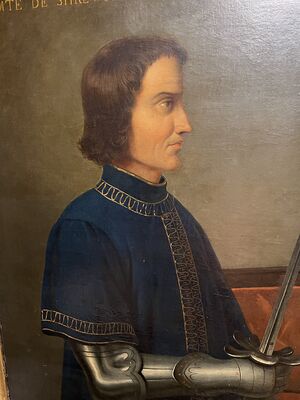Biography
Sir John Fastolf was born on November 6, 1380 in Caister, Norfolk, England.
He was the son of a Norfolk gentleman, Sir John Fastolf of Caister-on-Sea and his wife Mary Park. He was the Duke of Bedford's Master of the Household and was Governor of the province of Maine and Anjou.
He married Milicent Tibetot, daughter of Sir Robert de Tibetot 3rd Lord Tibetot and Margaret Deincourt, on 13 January 1409 at Ireland. She was considerably older than him and they had no issue.[1][2][3] This marriage brought him significant amounts of land, including the manors of Castle Combe and Bathampton in Wiltshire, Oxenton in Gloucestershire, and several properties in Somerset and Yorkshire
John was immortalised by Shakespeare in this speech from Henry IV Part 1 uttered by Shakespeare’s much loved character Falstaff.[4] Shakespeare's creation was in fact based on the real knight, Sir John Fastolf of this profile:
- "What is in that word honour? Air. A trim reckoning! Who hath it? He that died o’ Wednesday. Doth he feel it? No. Doth he hear it? No. Is it insensible then? Yea to the dead…"
Another famous phrase uttered by Falstaff in Henry IV part 1 that is widely known is:
- "The better part of valour is discretion".
Today, however, it is celebrated as an idiom of conventional wisdom rather than an expression of cowardice. Unintentionally it serves to pay tribute to the military prudence that made Sir John Fastolf the loyal and distinguished soldier he was.
The Falstaff of Shakespeare’s plays was a character embellished and developed in his own right for the purpose of entertaining audience and bore little resemblance to what we understand of the real soldier. He had a distinguished military career in Ireland and France, which challenges the image of Shakespeare’s buffoon.
The real Fastolf was a professional, late medieval soldier who forged an impressive military career serving three English kings: Henry IV, V and VI. He entered the retinue of King Henry IV's second son, Thomas of Lancaster (later Duke of Clarence), under whose service he remained until 1415. Thomas had been appointed by his father to keep order in Ireland, and it was there that Fastolf first saw military action. Fastolf's commanding officer was Sir Stephen Scrope, whose widow he married after Scrope's death in 1408.
In February 1429 Fastolf led a convoy of supplies to English armies besieging Orleans with an Anglo-Parisian force and defeated a superior French army near Rouvray-Sainte-Croix. The victory was popularly known as the battle of ‘the Herrings’ because of the large quantities of fish among the supplies. It was to be the zenith of Fastolf’s military career.
Four months after triumphing at Rouvray, an event occurred by which Fastolf would be judged by history, and that inspired William Shakespeare. On 18 June 1429 an English army was heavily beaten by a resurgent French force at Patay. Fastolf was part of that army but rather than engage, as his fellow commander the Lord John Talbot did, he withdrew with the body of men under his command.
Accused of cowardice, Fastolf was stripped of his position as a knight of the Order of the Garter. It would take Fastolf 13 years to clear his name.
Fastolf was not only a soldier, but a patron of literature, a writer and strategist. In 1435, he drafted a document proposing a new strategic approach to the war in France. In it, he criticizes current policy based on a war of sieges and proposes instead an offensive strategy based on large scale chevauchées, a raiding method of medieval warfare for weakening the enemy. He died on 6 November 1459 and was buried in the Abbey Church, St. Benet's at Holm, in Horning, Norfolk, England.[1][3]
Sources
- ↑ 1.0 1.1 The Complete Peerage of England, Scotland, Ireland, Great Britain, and the United Kingdom, by George Edward Cokayne, Vol. XII/2, p. 97, notes.
- ↑ Douglas Richardson, Magna Carta Ancestry, 2nd Edition, Vol. IV, p. 196.
- ↑ 3.0 3.1 Douglas Richardson, Royal Ancestry, Vol. V, p. 165.
- ↑
Wikipedia entry:
Wikipedia contributors, "Henry IV, Part 1"
Wikipedia, The Free Encyclopedia (accessed 13 July 2024)
- Wikipedia entry: Wikipedia contributors, "John Fastolf"
Wikipedia, The Free Encyclopedia (accessed 13 July 2024) - Surrey Archaeological Collections (Surrey Archaeological Society, 1864) Vol. 2, Page 68
No known carriers of John's ancestors' DNA have taken a DNA test. Have you taken a test? If so, login to add it. If not, see our friends at Ancestry DNA.
Rejected matches › John Fastolf (abt.1370-)
This week's featured connections are Acadians: John is 20 degrees from Joseph Broussard, 21 degrees from Louis Hebert, 24 degrees from Antonine Maillet, 22 degrees from Roméo LeBlanc, 23 degrees from Aubin-Edmond Arsenault, 24 degrees from Louis Robichaud, 23 degrees from Cleoma Falcon, 25 degrees from Rhéal Cormier, 25 degrees from Jack Kerouac, 25 degrees from Maurice Richard, 25 degrees from Ron Guidry and 26 degrees from Beyoncé Knowles-Carter on our single family tree. Login to see how you relate to 33 million family members.


